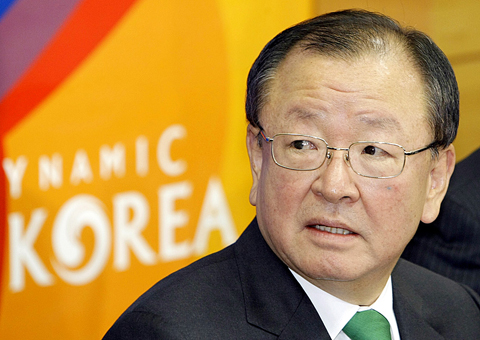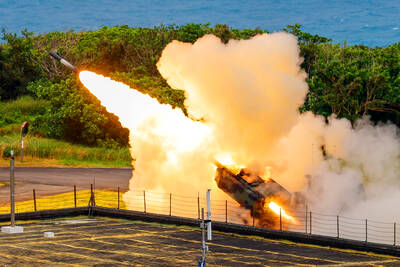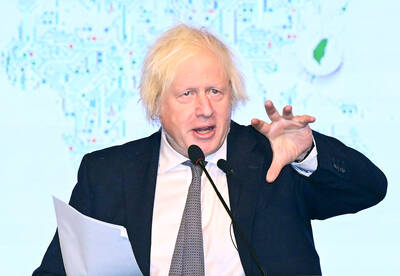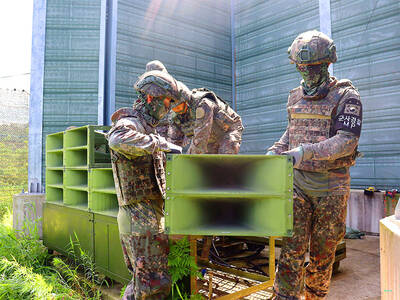South Korea yesterday announced a US$10.7 billion plan to stimulate economic growth in the face of a global slowdown.
The government, saying it expects a significant slowdown in exports, detailed plans to spend an extra 11 trillion won next year, plus tax cuts totaling 3 trillion won, to boost sagging domestic demand.
“The ongoing global financial turmoil originating from the US subprime mortgage credit crunch is causing concern over a global economic downturn,” Minister of Strategy and Finance Kang Man-soo told reporters.

PHOTO: AP
“Financial market uncertainties have been aggravated and are exerting a knock-on impact on the real economy,” he said, stressing the need for the package to stimulate Asia’s fourth largest economy.
The government, under fire for weeks over its perceived weak leadership amid the global crisis, announced a wide-ranging plan to stabilize the shaky won and to boost the economy.
The finance ministry, in a statement announcing the measures, said short-term prospects for a turnaround in the global turmoil appear dim.
“Against this background, the [South] Korean government proposes ... policy measures to cope with these unprecedented challenges by announcing pre-emptive, decisive and sufficient counter-measures,” it said.
Of the 11 trillion won in extra public spending proposed for next year, 4.l6 trillion won would be spent on social infrastructure such as schools, universities, hospitals and libraries. Another 3.4 trillion would be used to help small and medium-sized firms, farmers and fishermen. One trillion won would be used to help low-income households and 1.1 trillion to support local governments. In addition to government spending, public enterprises would also expand investment by 1 trillion won.
Next year’s original budget submitted to parliament this month was for 273.8 trillion won, including spending by state-run funds, based on an assumption of 5 percent growth next year.
But the ministry yesterday cut its growth forecast for next year to around 4 percent, while tipping growth of 4 percent to 4.5 percent this year.
It announced a series of steps to revitalize the sagging property market, warning that “a potential sharp drop in asset prices may undermine the financial health of [South] Korean financial institutions.”
These largely ease restrictions imposed in recent years to curb speculation when the property market was soaring. South Korea had been dogged by fears of a re-run of the 1997-1998 financial crisis, partly because its banks were more exposed than elsewhere in Asia to repayment of dollar-denominated loans.
Last month, the government announced state guarantees worth up to US$100 billion on foreign borrowing by local banks. It followed up last week with news of a currency swap arrangement worth US$30 billion with the US Federal Reserve.
The news sharply pushed up the stock market and the won, which had been Asia’s worst performing major currency this year.
The finance ministry said yesterday it would also try to expand bilateral swap arrangements with China and Japan.
It said it would increase the ceiling of the foreign exchange stabilization fund from the current 15 trillion won to 20.6 trillion won, equivalent to twice the average daily exchange trading volume.
Extra funds would go to promote exports, while efforts to reach free trade deals with the EU and India would be speeded up.
Authorities would try to avoid “extreme volatilities” in the foreign exchange market with smoothing operations. And Foreign currency bank deposits would enjoy the same level of guarantees as local currency deposits.

Authorities have detained three former Taiwan Semiconductor Manufacturing Co (TMSC, 台積電) employees on suspicion of compromising classified technology used in making 2-nanometer chips, the Taiwan High Prosecutors’ Office said yesterday. Prosecutors are holding a former TSMC engineer surnamed Chen (陳) and two recently sacked TSMC engineers, including one person surnamed Wu (吳) in detention with restricted communication, following an investigation launched on July 25, a statement said. The announcement came a day after Nikkei Asia reported on the technology theft in an exclusive story, saying TSMC had fired two workers for contravening data rules on advanced chipmaking technology. Two-nanometer wafers are the most

DEFENSE: The first set of three NASAMS that were previously purchased is expected to be delivered by the end of this year and deployed near the capital, sources said Taiwan plans to procure 28 more sets of M-142 High Mobility Artillery Rocket Systems (HIMARS), as well as nine additional sets of National Advanced Surface-to-Air Missile Systems (NASAMS), military sources said yesterday. Taiwan had previously purchased 29 HIMARS launchers from the US and received the first 11 last year. Once the planned purchases are completed and delivered, Taiwan would have 57 sets of HIMARS. The army has also increased the number of MGM-140 Army Tactical Missile Systems (ATACMS) purchased from 64 to 84, the sources added. Each HIMARS launch pod can carry six Guided Multiple Launch Rocket Systems, capable of

CHINA’s BULLYING: The former British prime minister said that he believes ‘Taiwan can and will’ protect its freedom and democracy, as its people are lovers of liberty Former British prime minister Boris Johnson yesterday said Western nations should have the courage to stand with and deepen their economic partnerships with Taiwan in the face of China’s intensified pressure. He made the remarks at the ninth Ketagalan Forum: 2025 Indo-Pacific Security Dialogue hosted by the Ministry of Foreign Affairs and the Prospect Foundation in Taipei. Johnson, who is visiting Taiwan for the first time, said he had seen Taiwan’s coastline on a screen on his indoor bicycle, but wanted to learn more about the nation, including its artificial intelligence (AI) development, the key technology of the 21st century. Calling himself an

South Korea yesterday said that it was removing loudspeakers used to blare K-pop and news reports to North Korea, as the new administration in Seoul tries to ease tensions with its bellicose neighbor. The nations, still technically at war, had already halted propaganda broadcasts along the demilitarized zone, Seoul’s military said in June after the election of South Korean President Lee Jae-myung. It said in June that Pyongyang stopped transmitting bizarre, unsettling noises along the border that had become a major nuisance for South Korean residents, a day after South Korea’s loudspeakers fell silent. “Starting today, the military has begun removing the loudspeakers,”